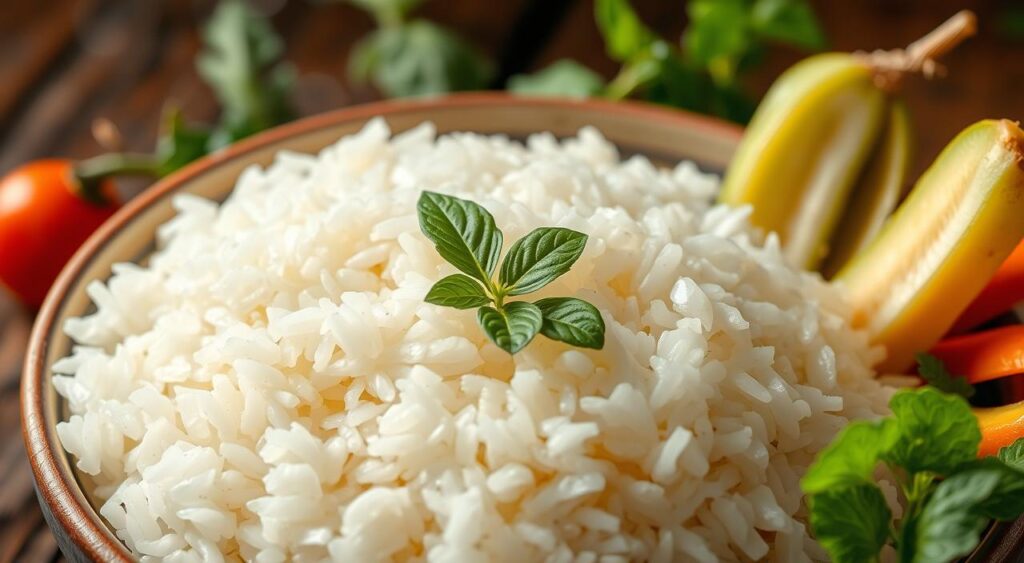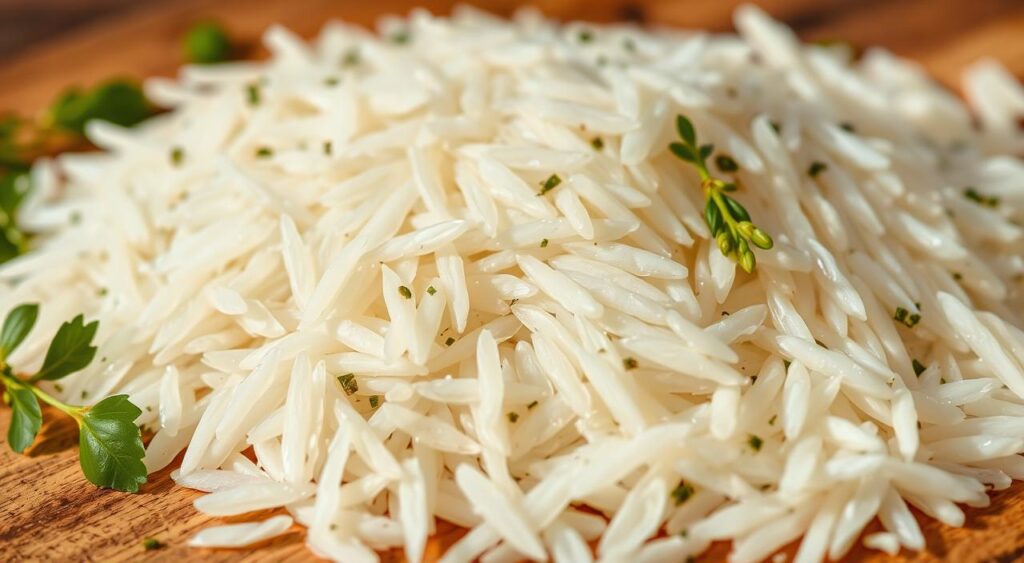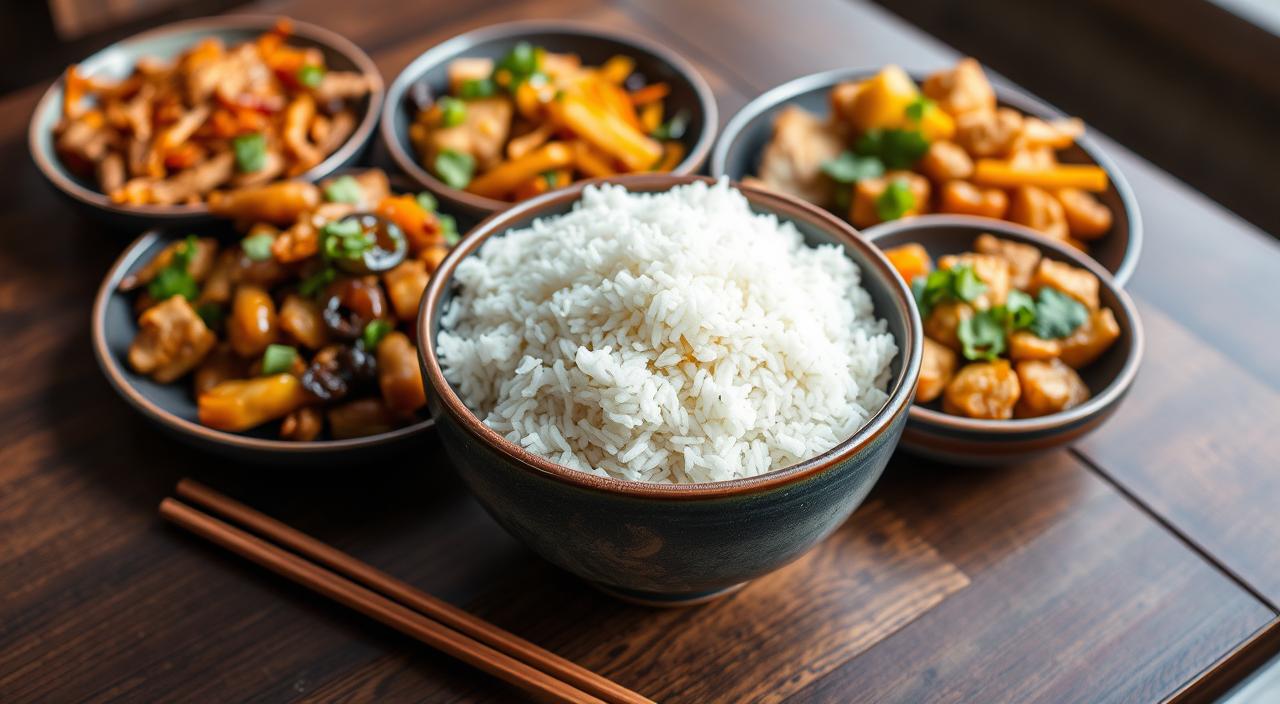I love cooking at home and exploring Asian flavors. For me, the key to any dish is the rice. Mahatma Jasmine Rice is the top choice for Asian dishes.
Mahatma Jasmine Rice is a long grain rice that captures the essence of Asian cooking. It has a sweet, floral scent and a fluffy texture. It’s perfect for curries and fried rice, making any dish special.
This rice is not just tasty; it’s also good for you. It’s gluten-free and non-GMO. So, you can enjoy Asian dishes without worrying about your health.
Don’t settle for less in your Asian dishes. Try Mahatma Jasmine Rice and open up new cooking possibilities. Your dishes will look great and taste amazing.
Understanding Mahatma Jasmine Rice Basics

Mahatma Jasmine Rice is a top-notch rice known for its amazing smell and soft, fluffy texture. It’s non-GMO and gluten-free, making it great for many dishes. It can really make your favorite Asian meals stand out.
What Makes Jasmine Rice Special
Jasmine rice is special because of its sweet, floral smell and its soft, sticky feel when cooked. It has just 160 calories in a 1/4 cup serving, making it a healthy choice. Plus, it’s free from MSG, preservatives, and other additives, so it’s clean and wholesome for your cooking.
Nutritional Benefits and Values
Mahatma Jasmine Rice is packed with complex carbs, giving you 36 grams per serving. It also has 3 grams of protein, which makes it filling and satisfying. This rice is gluten-free and non-GMO, so it fits many diets.
Non-GMO and Gluten-Free Properties
Mahatma Jasmine Rice is verified non-GMO by the Non-GMO Project, so it’s free from genetically modified organisms. It’s also gluten-free, which is great for those who need to avoid gluten. Enjoy the real taste and texture of Mahatma premium rice without any bad additives.
“Mahatma Jasmine Rice is a true delight for the senses, with its captivating aroma and delightful texture. It’s the perfect foundation for creating authentic Asian cuisine at home.”
Perfect Cooking Techniques for Jasmine Rice

Jasmine rice is a favorite long grain rice that needs a little care to get it just right. The best water-to-rice ratio is 1.5:1. If you want it drier, use 1/4 cup less water for each cup of rice. For a moister rice, add 1/4 cup more water.
You can cook jasmine rice on the stovetop, in a rice cooker, slow cooker, or even in the microwave. Unlike basmati rice, you don’t need to soak it first.
For fried rice, the ratio changes. Cook jasmine rice with 1/4 cup less water than the usual 2:1 ratio. This makes the rice drier, which is great for stir-frying. It helps the grains separate well and soak up flavors.
“The secret to perfectly cooked jasmine rice lies in getting the right water-to-rice ratio. With a little practice, you’ll be whipping up restaurant-quality rice dishes in no time.”
Mastering jasmine rice cooking is key for any meal, simple or elaborate. Its unique aroma and soft texture make it a standout rice variety. Try different cooking methods and ratios to find your favorite way to cook long grain rice.
Essential Asian Curry Dishes with Jasmine Rice
Looking for the perfect rice for Asian curries? Mahatma Jasmine Rice is your answer. It’s fragrant and aromatic, making it perfect for soaking up curry sauces. This enhances your dining experience.
Thai Curry Variations
Thai curries have three main types: red (spiciest), green (medium heat), and yellow (mildest). Mahatma Jasmine Rice pairs well with all, offering a creamy texture. It lets you enjoy every spoonful.
Coconut Curry Combinations
Coconut milk is key in many Thai curry recipes, like Coconut Curry Chicken Burritos. Mahatma Jasmine Rice has a mild, nutty flavor. It balances the coconut sauce’s creaminess.
Traditional Curry Serving Methods
In true Asian cuisine, curries are served over fluffy Mahatma Jasmine Rice. This lets the rice absorb all the flavors. It makes the dish look great and tastes even better.
“Mahatma Jasmine Rice is the ultimate basmati alternative for crafting flavorful and authentic Asian curry dishes.”
Mastering Restaurant-Style Fried Rice
Creating the perfect fried rice at home starts with the right rice. Premium long grain rice or jasmine rice is key. Mahatma® Long Grain and Jasmine Rice Blend is a great pick. Its long grains stay perfect in the wok, making each bite just right.
The secret to great fried rice is using day-old or chilled rice. This rice fries up crisp and separate, not mushy. Start by cooking aromatics like garlic, ginger, and onions in sesame oil. Then, add cooked rice, soy sauce, and your favorite veggies or proteins.
“For the best fried rice, use a premium long grain rice like Mahatma® Jasmine Rice. The long, slender grains create the perfect texture.”
Fried rice is all about personal taste. Add Thai flavors with curry, fish sauce, and herbs. Or, try a Hibachi twist with butter and soy sauce. The goal is to fry it over high heat for a crunchy, caramelized edge.
Learning to make fried rice at home is a fun journey. With the right long grain rice and a few tricks, you can make amazing fried rice any time.
Traditional Asian Sauces and Marinades
Take your aromatic rice dishes to the next level with Asian sauces and marinades. Soy sauce and sriracha add deep, rich flavors. These sauces are key to authentic Asian dishes.
Try different sauces to add complexity to your jasmine rice. Each one brings its own unique taste.
Essential Asian Sauce Combinations
Learn to mix sauces for amazing Asian flavors. Soy sauce, fish sauce, and oyster sauce create a savory base. Add hoisin sauce for sweetness or sriracha for heat.
This mix of flavors will make your taste buds travel to Asia.
Regional Sauce Variations
Explore Asia’s diverse sauces. Try Indonesia’s spicy sambal, Korea’s fermented doenjang, and Japan’s citrusy ponzu. These sauces add vibrant flavors and show off each region’s culture.
“Sauces are the soul of Asian cuisine, elevating even the simplest rice dish into a symphony of flavors.”
Get creative with Asian sauces and marinades. They’re great for stir-fries and marinades. Use them to make your jasmine rice dishes stand out.
Authentic Asian Desserts with Jasmine Rice
Get ready for a journey into the world of authentic Asian desserts. Jasmine rice is the star here. You’ll find everything from Mango Sticky Rice to Horchata Whipped Ice Coffee. These treats show how versatile premium rice can be.
Mango Sticky Rice is a favorite from Thailand. It’s made with jasmine rice cooked in coconut milk. This creates a creamy base that’s perfect with fresh mangoes. Making it is a labor of love, but the taste is worth it.
Try the Sweet Arancini for a twist on Italian fried rice balls. They use Mahatma® Arborio Rice. These treats have a crispy outside and a creamy inside, making them a hit worldwide.
“The tradition of making mochis, round bite-sized rice cakes originating from Japan, is a labor-intensive activity that has become an international food trend.”
In Latin America, you’ll find Rellenitos. They mix refried black beans, jasmine rice, and plantains for a mix of flavors. Tamales can also be sweet, using Mahatma® White Rice and ingredients like berries or nuts.
Horchata, a rice-based drink from Latin America, is another highlight. And don’t miss the Rice Fritters, like Louisiana’s calas. The world of jasmine rice desserts is full of treasures waiting to be tried.
Comparing Jasmine Rice with Other Rice Varieties
Choosing the right rice for your Asian dishes can be tough. You might wonder if jasmine rice or basmati rice is better. Both are long-grain aromatic rices, but they’re different in many ways.
Jasmine vs Basmati Rice
Jasmine rice comes from Thailand and has a light buttery smell. It cooks soft and slightly sticky. On the other hand, basmati rice from the Himalayas has a floral scent and is fluffy with separate grains.
Jasmine rice is great for Thai and Southeast Asian dishes. Basmati rice is best for Indian and Middle Eastern meals.
Long Grain vs Aromatic Rice Options
There are more long-grain rice options besides jasmine and basmati. Long-grain white rice is versatile and works in many dishes. Short-grain rice, like sushi rice, is sticky and perfect for sushi and sticky rice.
The right rice choice depends on your dish and what you want it to taste and feel like.
Choosing jasmine or basmati rice can make your Asian dishes even better. Knowing the differences between these long-grain aromatic rices can help you cook amazing meals.
Modern Kitchen Appliance Cooking Methods
In today’s kitchens, cooking rice is easier than ever thanks to various appliances. Jasmine rice, a top premium rice choice, can be cooked in many ways. This makes it a favorite for many.
Using an Instant Pot is a quick and easy option. Just use a 1:1 ratio of rice to water. This method uses less water than usual, making the rice fluffy and flavorful.
For those who like the ease of a rice cooker, it’s a great choice. Follow the same 1:1 ratio as stovetop cooking. This ensures perfect results every time. It lets you focus on other parts of your meal while the cooker does the work.
“The beauty of cooking jasmine rice in modern appliances lies in the consistent, hassle-free results, allowing you to enjoy the unique flavors and textures of this premium rice variety.”
Some cooks still prefer the stovetop method for more control. But, Instant Pot and rice cooker cooking are favorites for their ease and reliability. They’re perfect for busy homes.
Conclusion
Mahatma Jasmine Rice is a versatile, aromatic rice that makes meals special. It adds a unique flavor to both savory dishes and desserts. This mahatma jasmine rice is key for authentic Asian tastes in your kitchen.
The rice has a distinct aroma and a slightly sweet taste. It goes well with many ingredients. Its cooking quality and health benefits make it a favorite for those watching their diet.
Trying Mahatma Jasmine Rice can open up new culinary adventures. It’s perfect for both traditional and modern dishes. This rice variety will make your meals more exciting and flavorful.
FAQ
What makes Mahatma Jasmine Rice special?
Mahatma Jasmine Rice is a long grain rice perfect for Asian dishes. It has a sweet smell and fluffy texture. This makes it great for curries and fried rice.
It’s gluten-free, non-GMO, and good for vegans and vegetarians. People use it in Thai, Indian, and Cambodian cooking, and even in fusion recipes.
What are the nutritional benefits and values of Jasmine rice?
Jasmine rice is known for its smell and soft texture. It has 160 calories per 1/4 cup. It’s non-GMO and gluten-free, making it good for many diets.
It doesn’t have MSG or added preservatives.
Is Mahatma Jasmine Rice non-GMO and gluten-free?
Yes, Mahatma Jasmine Rice is non-GMO verified and gluten-free. This makes it good for many diets.
How do you cook Jasmine rice?
Use 1.5 cups of water for every 1 cup of Jasmine rice. For drier rice, use less water. For moister rice, add more water.
Jasmine rice cooks well on the stovetop, in a rice cooker, slow cooker, or microwave. Unlike basmati, it doesn’t need soaking. For fried rice, cook with 1/4 cup less water than usual.
What are the best Asian curry dishes to serve with Jasmine rice?
Jasmine rice is perfect with Asian curries. Thai curries come in red, green, and yellow varieties. Coconut milk is often used in them.
Jasmine rice is great for soaking up curry sauces. This enhances the dining experience.
How can I make restaurant-style fried rice with Jasmine rice?
Jasmine rice is best for fried rice. Mahatma Long Grain Rice & Jasmine Rice Blend works well. Use garlic, ginger, sesame oil, and soy sauce for flavor.
Thai fried rice often includes curry powder or pineapple. For the best taste, use day-old rice or cool it in the freezer for an hour before frying.
What are some essential Asian sauces and marinades to use with Jasmine rice?
Asian sauces make jasmine rice dishes better. Soy sauce, fish sauce, and oyster sauce are popular. Hoisin sauce and sriracha are also great.
Regional sauces like Indonesian sambal, Korean doenjang, and Japanese ponzu add variety. Use them in stir-fries, as marinades, or as condiments.
Can Jasmine rice be used in desserts?
Yes, jasmine rice is great in desserts. A popular Thai dessert is Mango Sticky Rice. It’s made with coconut milk and served with mango.
Other sweet dishes include Jasmine Rice Pudding Milkshake with Coconut and Horchata Whipped Ice Coffee. These desserts show the rice’s ability to absorb flavors and create creamy textures.
How does Jasmine rice compare to Basmati rice?
Jasmine and basmati are both long-grain aromatic rices. But they’re different. Jasmine rice has a subtle buttery smell and cooks soft and slightly sticky.
Basmati rice has a floral aroma and cooks fluffy with separate grains. Jasmine rice is best for Thai and Southeast Asian dishes. Basmati is traditionally used in Indian and Middle Eastern cooking.
How can I cook Jasmine rice in modern kitchen appliances?
Jasmine rice cooks well in modern appliances. For Instant Pot, use a 1:1 rice-to-water ratio. In a rice cooker, use the same ratio as stovetop cooking.
These methods are convenient and give consistent results. Some people prefer traditional methods for better texture and flavor control.
